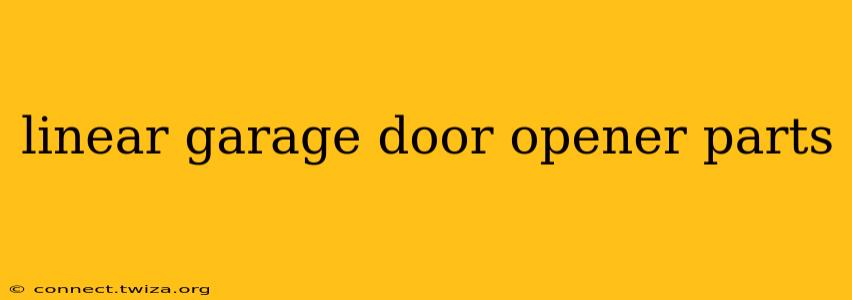Linear garage door openers are known for their reliability and smooth operation. However, like any mechanical device, they require occasional maintenance and may experience part failure over time. Understanding the different parts of your Linear garage door opener and how they function can help you troubleshoot problems, perform routine maintenance, and even complete minor repairs yourself. This guide will delve into the key components, common issues, and troubleshooting tips for Linear garage door openers.
What are the main components of a Linear garage door opener?
A Linear garage door opener, despite its seemingly simple operation, is comprised of several interconnected parts working in harmony. The key components include:
-
Motor Unit: This is the powerhouse of the system, responsible for generating the force needed to open and close your garage door. Linear openers typically utilize a direct-drive or belt-drive system. Direct-drive motors are known for their quiet operation, while belt-drive systems offer a balance between quiet operation and durability. The motor itself contains the electrical components and the gearing mechanism.
-
Control Board: The brain of the operation, the control board receives signals from the remote, wall switch, and other sensors, coordinating the motor's actions. This is where troubleshooting often begins if you experience malfunctions.
-
Logic Board (often integrated with the Control Board): This component manages the safety sensors, limit switches, and overall operational logic of the opener.
-
Remote Control: This handheld transmitter sends radio signals to the receiver in the opener, initiating the opening or closing sequence. Linear offers several different remote models, with varying features and capabilities.
-
Safety Sensors (Infrared Beam): Located near the bottom of the garage door opening, these sensors detect obstructions in the path of the door. If an object is detected, the door will reverse to prevent accidents.
-
Limit Switches: These switches, usually adjustable, determine the open and closed positions of the garage door. Improperly adjusted limit switches can cause the door to not open or close completely, or to stop prematurely.
-
Drive Chain or Belt (depending on the model): This connects the motor to the trolley that moves along the track, translating the rotational motion of the motor into linear motion for the door.
-
Trolley: This carriage rides along the track, connecting to the garage door. It's the component that directly pulls or pushes the door open and closed.
-
Rail/Track System: The guide for the trolley to move along, ensuring the smooth and stable operation of the door.
-
Garage Door (obviously!): While not strictly a part of the opener itself, its condition heavily impacts the overall system’s performance. A damaged or unbalanced door will strain the opener and reduce its lifespan.
How do I troubleshoot a malfunctioning Linear garage door opener?
Troubleshooting a Linear garage door opener often involves systematically checking the different components:
-
Check the Power Supply: Ensure the opener is properly plugged in and that the circuit breaker hasn't tripped.
-
Inspect Safety Sensors: Ensure the safety sensors are clean, aligned, and not obstructed. A misalignment or obstruction can prevent the door from operating.
-
Test the Remote: Try using different remotes (if available) to see if the issue lies with the remote control or the opener itself. Check the batteries in your remote.
-
Examine the Limit Switches: Verify that the limit switches are properly adjusted to match the opening and closing positions of the garage door.
-
Check the Drive Chain/Belt: Inspect for any signs of damage, wear, or slippage. A worn chain or belt can cause issues with the door's movement.
What are common Linear garage door opener problems?
Some of the most frequently reported problems with Linear garage door openers include:
-
Door won't open or close: This could be due to several factors, including power issues, problems with the safety sensors, faulty limit switches, or a problem with the motor unit itself.
-
Door opens and closes slowly: This might indicate a worn chain/belt, a failing motor, or an accumulation of debris in the moving parts.
-
Unusual noises during operation: Grinding, clicking, or other strange sounds often signal the need for lubrication, repair, or replacement of certain parts.
-
Remote doesn't work: This could be due to weak or dead batteries, interference from other electronic devices, or a problem with the receiver in the opener unit.
-
Safety sensors constantly trigger: This typically means something is obstructing the path of the infrared beam.
Where can I find Linear garage door opener replacement parts?
While this guide focuses on providing information and doesn't promote specific vendors, it is worth noting that replacement parts for Linear garage door openers can often be found through online retailers specializing in garage door supplies, local hardware stores, or directly from authorized Linear service centers. Always ensure the part you order is compatible with your specific model number. This information is usually found on a sticker affixed to the opener itself.
This comprehensive guide aims to help homeowners better understand their Linear garage door opener and troubleshoot common issues. Remember, safety is paramount when working with garage door openers. If you are unsure about performing any repairs, consult a qualified garage door technician.
